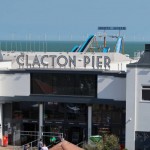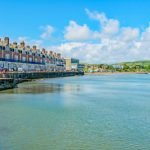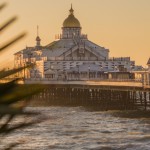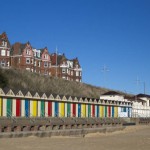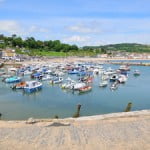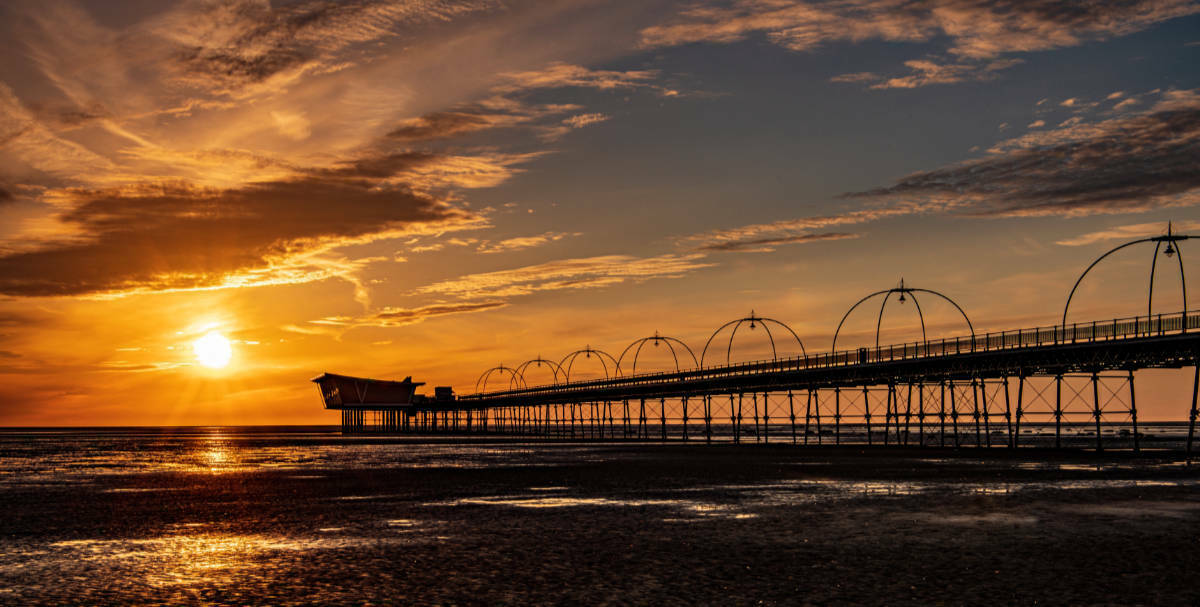
Could this seaside resort be the ideal holiday destination for you? We say it’s worth a visit.
Just south of the Ribble Estuary in the Irish Sea, you will find Southport. Southport is situated 14 miles from Preston and 16 miles from Liverpool. Found on the East Coast of England, this large seaside resort town has attracted thousands of visitors over the years. Southport was one of the many seaside resorts built during the Victorian era.
The arrival of the steam train meant that day trips to the seaside were suddenly popular. However, there was a small village on the site of Southport before the large town grew. Let’s examine the history of Southport and of the small village that preceded it. Later, we will review some of the best sights and sounds of the town for those who wish to visit.
The early days of Southport
Before Southport was the large town that we know and love today, it was known as South Hawes. Sand dunes occupied this area and not much else. However, it had seen population since at least the Stone Age. The area would have been brimming with red deer and elk. There was a full woodland as a resource, as well as access to fish.
Southport is situated on the Sefton coast. The Sefton Coast has seen Stone Age activity, which we know about through archaeological discoveries. researchers have found Stone Age footprints on the coast, which became encased in mud and preserved all these years. They have also found a 7000 year old Stone Age Flint piece on the beach. Early humans used flint for tools because it was so hard. Flint grows in vugs in the landscape and has a hardness high enough to make it useful for everything from hammers to axes to arrowheads.
Sources say that the Romans never settled here, even though there were Roman coins found in the area. That’s Roman, as in they came from Italy, rather than Roman as in the Women’s clothes shop on Southport high street. They would certainly have passed through the area on their way north. We know that they reached all the way up into Scotland.
To this day, there remains an area of Southport known as South Hawes. It is a parish of its own, found in the cottages South of Churchtown.
According to Wikipedia, the land where Southport now stands was known in the Domesday survey as Ottergimele. They record that this area had about 50 huts and a population of nearly 200 people. They also ascertain that scattered sand would have given way to alluvial deposits from the River Ribble estuary. When we searched for the record of Ottergimele in the Open Domesday archives, we could not find it. We could only find an entry for the nearby Ainsdale, which was worth 5 shillings and 2 pence, and belonged to Roger of Poitou. He owned huge swathes of land as one of William the Conqueror’s favourites. Whatever the truth of the matter, there were settlers on the land, if sparsely, at the time.
The whole area would later become known as Churchtown or Crossens. They would later become North Meol, the small village. Local church officials established the Church of St Cuthbert nearby. St. Cuthbert was a Saint of the Northumberland people. It has been a centre of the community ever since. Eventually, North Meol split into hamlets, one of which was Southport. There were several of these Hamlets, of which Crossens and Churchtown remain.
Before there was ever a Southport, there was Martin Mere. This area was surrounded by the sea on all four sides for much of the year. In 1692, a man named Thomas Fleetwood developed a plan to drain out the water and reclaim the land. Efforts to drain out the water continued right up until the end of the 19th century, when engineers introduced pumps to do the job. This left great arable farmland which is still in use today. It also led to a farming boom in the area. It is for towns such as Southport that we have such strict rules around destruction of the coast. When the people started to build there, they removed the natural sandbanks which stopped the tide from overtaking the land. Luckily for Southport the tide is notoriously shy.
Let’s take a break from the history to talk about some of the fun things that have happened in Southport over the years.
Fun trivia about Southport
Here at Five Minutes Spare, we love to scoop up the gossip on any given tour guide destination. Here’s what we found out about Southport:
- The Sefton Coast is sometimes nicknamed England’s Golf Coast. The area has hundreds of golf courses. The local Hesketh Golf Club was established in 1885 and was the first of many.
- Southport Pier is the oldest and second largest in the entire country. They completed Southport Pier in 1860 and it measures 1108 metres.
- Southport has its own sea walls as well as an offshore wind farm. The sandy beach at Southport is known as being one of the longest and there is a local urban myth that it never touches the shore. Nobody is sure why the tide is so shy.
- Lord St is the oldest street in town. The first official Southport house was built here in the 18th century[i].
- Lord Street is doubly famous because Napoleon of France left here for a brief time in the 1840s. He then took the design of Lord Street back to France and used it to develop boulevards. That’s quite a claim to fame.
- Grand National Legend Red Rum was often trained on Southport Beach.
That’s quite enough fun facts to be getting on with. Let’s turn their attention back to the history so that we can get to those all-important sites to see.
Industrial era Southport
The Industrial Revolution truly gave birth to the town of Southport. Its growth coincided with the Victorian love of the seaside. Queen Victoria herself was known to own a stretch of land on the sea and to regularly bathe there. This use of the sea by the aristocracy made it popular among the nobility to do the same. The true history of Southport begins when William Sutton, a property owner in Churchtown, set up a bathhouse.
Known as the Old Duke, William Sutton was the owner of the Blackpool inn – which stands on the site of the modern-day Heskith Arms. He was a smart man who was able to look at the canal systems around the UK and envision that they would soon reach Southport. He was also keen to cash in on the Victorian pastime of Sea bathing. To do this, he built a bathing house in the sand dunes just four miles away from the Leeds and Liverpool canal. The Leeds and Liverpool Canal was erected in 1792. This meant that he could get clientele who were coming into town via the canal to come to his bathhouse. Later, when the train line arrived, he would gain even more custom. The proximity of the Bath House to the sea meant that he had a steady supply of water and that he could shelter the modesty of Victorians who didn’t want to be seen in a bathing suit. He was a clever man.
A widow formerly from Wigan started a lodging house in the local area in 1797. This was meant to be a place where people could lodge while they visited the bathing house or the inn. Sutton responded by building a hotel next to his bathing house. The locals called this the Duke’s Folly. They did not realise the eccentricity of the old man would make him a fortune. He installed transport links between his bathing house, his hotel, his inn, and the canal. Pretty soon he was raking it in. The hotel was still on the site until 1854 when they demolished it for traffic purposes. There is a Dukes Folly hotel in town and there is also a Duke Street, both named after him.
In 1809, a passing writer described Sutton’s inn as a fashionable watering-place. Christ Church was built on Lord Street in 1821. This was the height of the resort town boom. Traders would have built shops later. Lord St would have stopped being just a street and a town would have grown around it. In the 1840s Napoleon III stayed here for a while. In 1848 the town became connected to Liverpool via the train line. Another lane was open in 1855, finally connecting Southport to Manchester. The town grew exponentially within this time. Many people came here to Holiday Inn, just didn’t go home. If you worked in a dusty city full of pollution, and you went away to the seaside for the weekend, and you had never seen the sea before, you’d probably stay too.
The first newspaper came to Southport in 1836. Ten years after that, the government appointed Improvement Commissioners, who acted much like a Council. They had the power to pave, light, and clean the streets. Southport got its first piped water supply in 1854, which would have done wonders for staving off disease. They didn’t build their cemetery until 1865, showing that it worked. Builders finished Southport Pier in 1860 and named it a feat of engineering at the time. It still is to this day. The town got a Public Library in 1878. By 1867, Southport was incorporated, and the first mayor was appointed. A reported 20,000 visitors came through Southport in 1820.
In December 1886, a ship known as Mexico was passing on its way from Hamburg and washed up onto the Ainsdale sands. One of the 2 lifeboats that was sent to rescue them was from Southport. Both lifeboats capsized and 27 men were killed. A third lifeboat managed to reach and retrieve the survivors from the ship. There was a lifeboat station in Southport, right up until 1926. Who knows what happened out there in the water that day? For one boat to get into trouble and two more to capsize, it must have been terrible.
Touchingly, the locals of Southport clubbed together in the 1980s and bought themselves a new lifeboat for the town. They station the new lifeboat in the old RNLI Lifeboat House, but it receives no help from the RNLI itself. If you are visiting, make sure you give money to the lifeboat fund.
Modern Southport
Electric trams arrived in Southport in 1904. They later replaced these with a bus service. In 1912 there was a huge expansion of the town to include the neighbouring village of Ainsdale. Birkdale has also fallen under the mantle of Southport in recent times.
Locals erected the Southport War Memorial just after the First World War and noted 1247 serviceman’s names. There are also three women’s names engraved onto the epitaph. Southport was the subject of a bombing raid in 1940 where they lost 5 civilians. The Germans notable bombed a home for blind babies in Birkdale. 17 people were killed by bombs dropped here during the war[ii].
In 1925, the lifeboat station lay abandoned. Then in 1926, Henry Seagrave set the land speed record on the sands of Southport. He was speeding along at 152.33 mph. He held the record for a whole month.
Southport gained its first theatre in 1973. This gave holidaymakers something else to do while they were visiting. Local council members restored Southport Pier in 2002. A model railway village opened in 1996. Let’s not forget the British Lawn Mower Museum, which opened in 1987.
The town gained the Ocean Plaza Shopping Centre before the turn of the century. New Pleasureland followed, opened in 2007. Splash World also opened in the same year. The Southport Pier tram has been running since 2005.
Modern-day Southport is a bustling community that has grown by about 10,000 people since the 70s. 90 thousand of us now called Southport Home and regularly walk those beaches. It is a busy seaside resort town that managed to hold its own over the years. Foreign holidays may be cheaper, but they don’t hold the nostalgia that Southport has[iii].
Famous people from Southport
Southport has its own varied blend of famous people. We picked out the Five Minutes Spare favourite famous people from Southport for your viewing pleasure. Here’s what we came up with:
- Actor Robin Askwith is from here.
- Berni Flint, from Opportunity Knocks, is a Southport singer.
- Marcus Wareing, the celebrity chef, is from here.
- Painter Adrian Scott Stokes.
- Neill McDermott from Eastenders.
There is an extensive list of folks that have come from Southport. Let’s not disappoint the world by continuing to add talent to it.
Meanwhile, there are lots of attractions in Southport that we haven’t even touched upon yet.
Things to do in Southport
Wondering what the top attractions are? Let’s take a peek.
Historic sites and landmarks
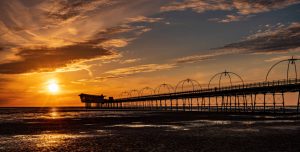
Image:Andy Hodkinson/Shutterstock.com
Southport Pier is the main historic landmark in town. Built in the Victorian era, it was refurbished in 2002. Southport Pier is the oldest iron pier in the country and the second largest. It is over 1000 metres long and is a Grade II listed building. It has its own tram and on a sunny day, you can see the North Wales coast.
Part historic site and part situated on top of the historic pier, Silcock’s Funland is the other semi-theme park in town. You find it at the entrance to the pier. It has snack bars, places to drink, and plenty of arcade games that you can spend your life savings on. Kids and adults both love this place because it gives you something to do in town even when the weather is bad.
Galleries and museums
You will find the best art gallery in town on Lord Street. Its name is the Atkinson and hosts an event space. They have a shop filled with handmade items from local crafters. They run regular shows and have guest speakers. The Atkinson also includes a museum of the Sefton Coast.
Take a trip out to Lytham Hall for the day and enjoy the architecture. Known for being the finest Georgian house in the entire county, this beautiful manor house is set in acres of stunning gardens. Even the gatehouses are perfect. It offers splendid views out over the countryside, and over Southport itself.
Outdoor attractions
You cannot visit Southport without stopping at the famous Model Railway village. Train lovers and children alike will find this perfectly replicated tiny village (complete with its own train) amazing. This is one of the longest miniature garden railway systems in the UK over 45 metres. It is set inside an acre and a half of a beautiful miniature landscape.
You will find a rival miniature railway track over at Southport Pleasureland. They built this one in 1945, so as a little older than the other village. Pleasureland has numerous other rides and games to keep the little ones amused. It even has its own themed rollercoaster.
There are dozens of outdoor attractions we just don’t have space for. As a resort town, Southport is big on outdoor attractions. Walk the Sefton Coastal Path or Victoria Park. Visit the shops on Wesley Street or take the kids to the King’s Gardens. You will never get bored here.
Sports and recreation
Southport Marina Lake has dozens of water-based activities for the family. The Victorians built Marina Lake and tourists describe it as “picturesque.” They offer pedalo rides/hire so you and your family can go out onto the water in your own swan-shaped boat.
The local football team are Southport FC and they play at their own stadium of the same name. It holds 6,000 people. Southport FC play in the National League, north.
The Sefton Coast is known unofficially as England’s Golf coast, and it didn’t fail to impress us. Southport Golf links and the Southport Old Golf Links courses are in town. To the south, for the serious golfers, there is the Hillside Golf Club and the Southport and Ainsdale Golf Club. The choice is yours.
Shopping and retail
For the best shopping in town, check out Cambridge Walks or the Wayfarer’s Arcade. Market Street has some good shops, and there are two shopping parks. Visit the C12 Shopping Park or the Ocean Plaza towards the seafront for more.
Where to eat and drink?
There is a wonderful tapas bar on Hoghton St. named Hoghton St Social. If you like Nepalese food then visit the Great Himalayas, Nepalese restaurant, and bar. And if you’re looking for Indian, try Kalash Devine Indian.
Other notable attractions in Southport
If you’ve made it this far, we obviously haven’t given you enough to do yet. Staying in Southport for a fortnight? Checkout some of these other top attractions:
- Take a wander through Southport Botanical Gardens. These beautiful gardens have their own lake and forest, complete with weeping willows and ducks.
- Visit the Lawn Mower Museum. No, but seriously.
- Follow the trail down Rotten Row, which they nicked from Rotten Row in Hyde Park, London.
- Visit Hesketh Park with the kids.
- Go to Splash world.
The list goes on and on. Seaside resorts always have lots of things to do. The only way to see them all is to check it out for yourself.
How to get there?
You are completely up to speed on all things Southport, but we should tell you how you get there. Follow these loose directions or ask someone who knows better.
By Road
Follow the M6 north/south until the A565.
By Rail
Southport Train Station is part of the Merseyrail line.
By Air
The nearest airport is Liverpool.
By Sea
Southport is not a port, nor does the tide come close enough.
Got 5 Minutes?
If you enjoyed our local guide to Southport and you would like to learn more, you can find all manner of detailed tour guides to local places over on Five Minutes Spare. Don’t forget to drop us a follow on Facebook too.
[i] https://www.merseyrail.org/destination-merseyside/articles/9-facts-you-didn-t-know-about-southport.aspx
[ii] https://www.southportvisiter.co.uk/news/history/world-war-ii-bombs-southport-9185270
[iii] https://localhistories.org/a-history-of-southport/
